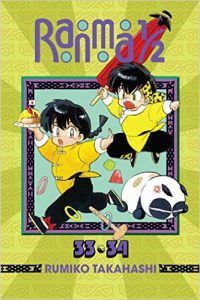By Rumiko Takahashi. Released in Japan by Shogakukan, serialized in the magazine Shonen Sunday. Released in North America by Viz. Translated by Kaori Inoue, Adapted by Gerard Jones.
And so at last we come to the end of the great Ranma 1/2 reissue. Inu Yasha may have had a broader reach, Urusei Yatsura may have had a bigger impact on Japan itself, and Maison Ikkoku may have had more maturity and resolution, but Ranma will still be THE anime gateway for many fans, along with Sailor Moon and Bubblegum Crisis. Having read the series again, I am able to see why it was so wildly popular, as well as why revisiting it can be frustrating. Ranma does not have depth – in fact, it actively leaps out of the way of depth – which makes it perfect for creative fans who want to give it that depth. It’s no coincidence that more than AMVs or fanart, it was fanfiction that was the biggest part of the mid-90s Ranma boom. Still, this does not mean that Takahashi’s manga is not good. It’s very good indeed.
Please do not be fooled by the cover – yes, there is a wedding at the end of the book, but we don’t even get to the ceremony before everything is completely destroyed and we return to the status quo. Well, status quo except that it seems that if there had not been chaos, Ranma and Akane might have gone through with the wedding. But there is always chaos in Ranma, it’s practically the main cast member. This manga ends much the same way that many of the classic UY anime episodes ended – with more and more of the cast showing up, each trying to beat up somebody else, until everything finally turns into a giant pile of destruction. Ranma 1/2 is not a romantic comedy, or a harem manga, or even a martial arts comedy. It’s pure slapstick.
The martial arts gets a good workout in the main part of this volume, though, as we return to China to battle another major villain. You get the sense that Takahashi is trying to figure out a way to top Herb, and she doesn’t manage it, really, but A for effort. The whole main cast is there (poor Ukyou, guess you were supporting after all), and there’s lots of cool fights and dramatic kicks and Akane and Shampoo in distress a lot of the time. That said, even when captured or dehydrated down to the size of a doll, Akane is still thinking hard and trying to get herself out of her predicament. Shampoo, alas, is merely mind-controlled most of the time. (I will note that Akane not noticing Ryouga transforming several times in this beggars belief, but hey.)
And so Ranma ends with our main couple waving goodbye to the readers as they head off to school again. It’s never quite confirmed that they do have mutual feelings for each other, mostly as I think Takahashi hoped people could read between the lines and see that she’d had them show their love without saying their love several times. (UY did this too – Ataru in particular was the poster child for “show, don’t tell”.) It didn’t quite work, and fans who disliked Akane were always quick to point out the open-endedness of the ending meant that they didn’t end up together. Takahashi later did one of those “character relationship charts”, filled with one-sided arrows, except for two – Ranma and Akane, and Ryouga and Akari. So she knew they loved each other.
But we don’t read Ranma for resolution of romantic tension. We read it for genderswapping and bizarre martial arts contests and so many fights and “Ranma no baka!” and in order to flesh out our 800,000 word epic fanfic with smatterings of actual canon. And we read it because we love the characters, flat as they are. Of course, we may not always love the SAME characters, but any Ranma fan is obsessed with at least one of them (except Happosai). Ranma 1/2 was a roadmap to modern anime fandom, and the road may be less traveled these days but it’s worth walking back over.



